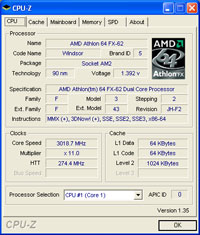Rich's Thoughts:
To be honest, I'm not entirely fussed about the metallic purple colour - it's just not deep enough to be metallic looking: the shade reminds me of children's toys a little too much. The layout is generally good, but there are some niggles - specifically the 4-pin ATX 12V plug, which is right next to the CPU socket. The SB600-powered IDE port could have been rotated too, for easier cable management.Even if the bundle is a little light, the board is sensibly inclusive of everything most people need. It’s made to save the odd buck here and there, not to go all out. After all, who really uses dual Gigabit Ethernet? The board features one of Realtek's HD audio codecs and even though it isn't the latest ALC888 codec, it is still generally very good and capable - we experienced no interference when subjectively listening to some music.
The inclusion of an extra IDE port is also clever for those who still use IDE drives for storage purposes, where you don't really need to upgrade to SATA. Having said that, the same controller still has a pair of SATA ports. ATI's SB600 - despite not having RAID 5 (which you should only use on a dedicated piece of hardware anyway) - has a massively improved USB 2.0 performance and comprehensive RAID coverage as well as SATA 3Gbps support, too.
Value: Value for money is pretty good though especially considering that the RD580 and SB600 combination is an expensive one, but ECS do save on the bundle for you. You can get RD580 and SB450 based motherboards for slightly cheaper, on the now-discontinued Socket 939, but really you want to spend the extra for AM2 and the far superior SB600 southbridge.
The best price in the UK currently is £88.42 including VAT, which isn't bad for a pretty solid high end motherboard. At this current time, I am unable to find a US supplier but no doubt this will change shortly within the coming weeks (we are under the impression that the board will ship in the second half of July in North America - Ed.). Expect it to be competitively priced against other mid-priced but high-end featured competitors.
Tim's Thoughts:
Using ECS' KA3 MVP was a generally trouble-free experience and there are very few things wrong with the board. The one sticking point is the lack of CAS Latency adjustment in BIOS at the moment - this severely hampered the performance, and destroyed the board's chance of getting a solid recommendation for avid tweakers. The rest of the BIOS is pretty good, but the KA3 could use some more comprehensive voltage adjustments.The layout isn't bad, but it's not without issue. Rich has already mentioned the positioning of the 4-pin 12V ATX connector, which is a bit of a pain to get to if you've got a generally large heatsink and it can also cause some nightmares when it comes to cable management, too. The other downside to layout is the number of expansion slots.
While Rich didn't make a big issue of this, I think it's worth mentioning again. If you're going to install two Radeon X1900s in CrossFire, there will only be a single PCI slot available for additional expansion options. This means that if AGEIA's PhysX was to take off in a big way, you would have to resort to on-board sound if you were using an X-Fi in the lone expansion slot. Having said that, Realtek ALC883 is good and music reproduction is generally very good through a pair of Sennheiser HD215's, but it lacks support for the latest version of EAX, which is so prevalent in gaming.
Overclocking & Stability: The KA3 MVP performed very well in our stress test, managing to successfully complete a 24-hour torture test consisting of two instances of Prime95, one instance of IOMeter and a continuous demo loop in Far Cry. One of the two Prime95 instances did report an error after 25 hours 30 minutes, and we're unsure why this happened. However, the fact that the board managed to last for 24 hours proves that the board is up to the task of being an enthusiast's motherboard. We fired up Call Of Duty 2 and Half-Life 2: Episode One after the stress test, and both ran fine.
Along with running the stress test, we overclocked the KA3 MVP using the 8.0x multiplier, to see how high we could get the HTT clock on the board without any stability issues. We managed to get the board stable at just under 286MHz with a 3.0x HTT multiplier. This was a little disappointing, especially when we've already had the HTT clock on our FX-62 up to 350MHz HTT on the ASUS M2N32-SLI Deluxe WiFi Edition. We also pushed for a max-overclock, getting the board stable at 11.0x274, equating to a 3018MHz CPU clock. When we pushed the CPU further, we encountered stability problems, and inconsistent POSTing.
Final Thoughts...
All in all - despite the its limitations with bundle, BIOS memory timings and the lone PCI slot - the ECS KA3 MVP is a stable and generally decent performing board. Given its price, you get what you pay for. The implementation of the SB600 southbridge much improves I/O performance and ECS makes CrossFire a more viable solution for cost concious buyers.
MSI MPG Velox 100R Chassis Review
October 14 2021 | 15:04








Want to comment? Please log in.